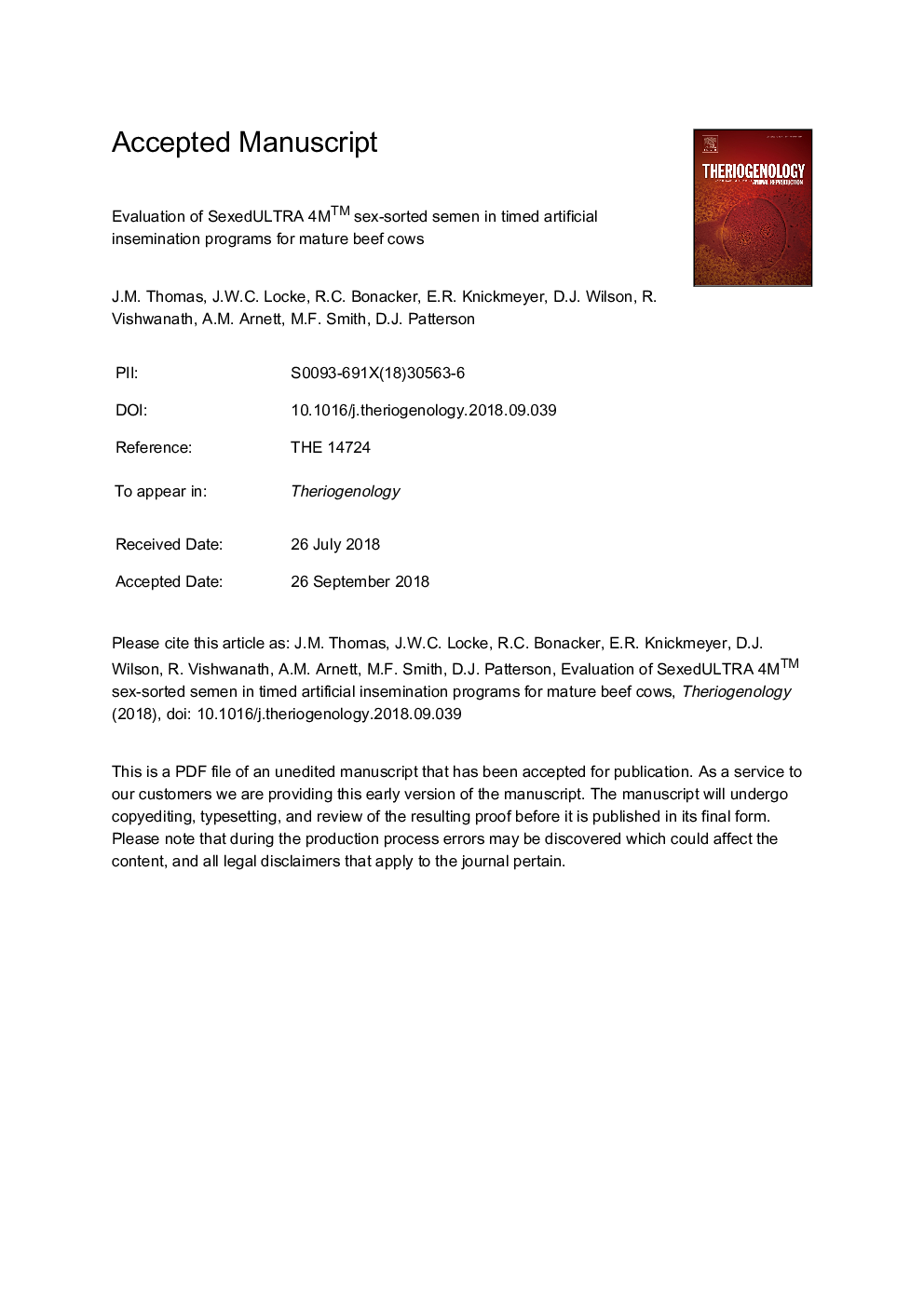| کد مقاله | کد نشریه | سال انتشار | مقاله انگلیسی | نسخه تمام متن |
|---|---|---|---|---|
| 11025954 | 1666464 | 2019 | 25 صفحه PDF | دانلود رایگان |
عنوان انگلیسی مقاله ISI
Evaluation of SexedULTRA 4M⢠sex-sorted semen in timed artificial insemination programs for mature beef cows
دانلود مقاله + سفارش ترجمه
دانلود مقاله ISI انگلیسی
رایگان برای ایرانیان
موضوعات مرتبط
علوم زیستی و بیوفناوری
علوم کشاورزی و بیولوژیک
علوم دامی و جانورشناسی
پیش نمایش صفحه اول مقاله

چکیده انگلیسی
An experiment was designed to compare fertility of SexedULTRA 4M⢠sex-sorted semen and conventional, non-sex-sorted semen following either fixed-time artificial insemination (FTAI) or split-time artificial insemination (STAI) of mature suckled beef cows. Units of sex-sorted and conventional semen were produced using contemporaneous ejaculates from three commercially available sires. Units of conventional semen were generated with 25.0â¯Ãâ¯106 live cells per 0.25â¯ml straw prior to freezing, and units of sex-sorted semen were generated using the SexedULTRATM Genesis III sorting technology with 4.0â¯Ãâ¯106 live cells per 0.25 ml straw prior to freezing. Sex-sorted units were sorted to contain X chromosome-bearing sperm cells at an accuracy level of >90%. Cows (n = 1620) across four herds were treated with the 7-d CO-Synch + CIDR protocol [administration of gonadotropin-releasing hormone (GnRH) and insertion of a progesterone insert (CIDR) on Day -10, followed by administration of prostaglandin F2α (PG) and removal of CIDR inserts on Day -3]. Cows were preassigned based on age, body condition score, and days postpartum to one of the following four treatments: FTAI with SexedULTRA 4M⢠sex-sorted semen, FTAI with conventional semen, STAI with SexedULTRA 4M⢠sex-sorted semen, or STAI with conventional semen. On Day -3, estrus detection aids (Estrotect®) were applied. For cows in FTAI treatments, AI was performed on Day 0 at 66â¯h after PG administration and CIDR removal, and 100â¯Î¼g GnRH was administered concurrent with AI. For cows in STAI treatments, AI was performed on either Day 0 or 1, at 66 or 90â¯h after PG administration and CIDR removal, based on timing of estrus expression. On Day 1â¯at 90â¯h after PG administration and CIDR removal, 100â¯Î¼g GnRH was administered concurrent with AI to any STAI-treated cows that had failed to express estrus. Pregnancy rates to AI were affected (Pâ¯=â¯0.04) by the interaction of bull and semen type. Greater pregnancy rates were obtained with conventional semen versus SexedULTRA 4M⢠sex-sorted semen when using semen from Bull A (64% [176/277] versus 36% [100/278]; Pâ¯<â¯0.0001) and Bull B (72% [200/277] versus 57% [156/276]; Pâ¯<â¯0.01), whereas pregnancy rates to AI did not differ between conventional and SexedULTRA 4M⢠sex-sorted semen when using semen from Bull C (58% [149/258] versus 52% [131/254]). Pregnancy rates did not differ significantly between cows inseminated using a STAI versus FTAI approach, regardless of whether insemination was performed with conventional semen (65% [265/409] versus 65% [260/403] or SexedULTRA 4M⢠sex-sorted semen (50% [200/403] versus 48% [187/405]). However, due to the additional 24â¯h for potential estrus expression when performing STAI, total estrous response prior to AI was greater (Pâ¯<â¯0.001) among cows receiving STAI (84%; 686/812) compared to FTAI (72%; 585/808), and greater pregnancy rates (Pâ¯<â¯0.0001) were obtained among cows that expressed estrus prior to AI. In summary, the relative fertility of SexedULTRA 4M⢠sex-sorted semen and conventional semen varied across bulls. Although overall pregnancy rates to timed AI did not differ between STAI and FTAI approaches, use of a STAI approach allowed for greater total estrous response prior to AI. Therefore, to achieve acceptable conception rates per unit and service the maximum number of cows with sex-sorted semen, one viable approach may be to use STAI to maximize total estrous response and restrict use of SexedULTRA 4M⢠sex-sorted to only those cows expressing estrus.
ناشر
Database: Elsevier - ScienceDirect (ساینس دایرکت)
Journal: Theriogenology - Volume 123, 1 January 2019, Pages 100-107
Journal: Theriogenology - Volume 123, 1 January 2019, Pages 100-107
نویسندگان
J.M. Thomas, J.W.C. Locke, R.C. Bonacker, E.R. Knickmeyer, D.J. Wilson, R. Vishwanath, A.M. Arnett, M.F. Smith, D.J. Patterson,